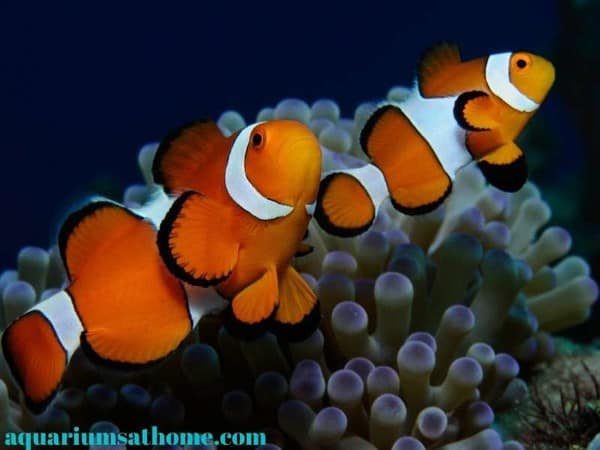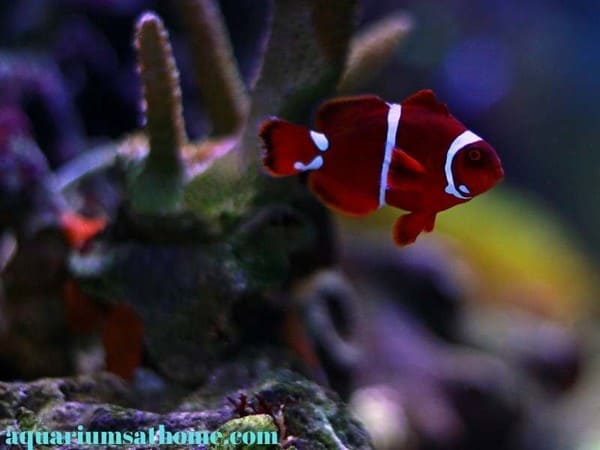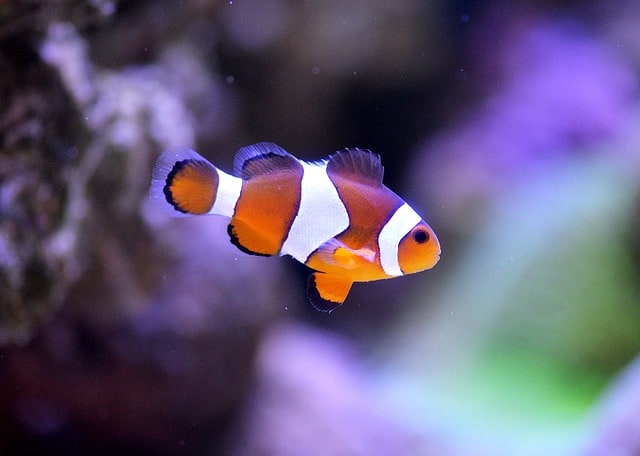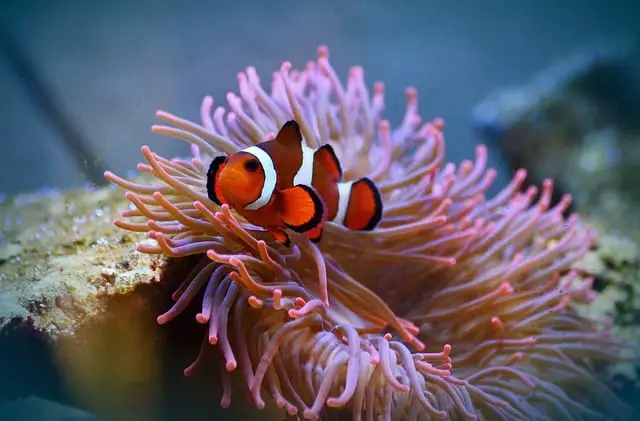Clownfish in captivity will often pair up, just like they do in the wild. If you’ve ever seen a nature or oceanic documentary on clownfish, you’ve likely noticed them in twos hovering above or within an anemone. If you’re thinking of keeping clownfish, you may be wondering how to tell if they’ve paired? The answer is…
There are physical signs that your clownfish are pairing up in an aquarium. It often starts with the male twitching when near the female. This is usually followed by the female asserting dominance over the male by chasing him about and nipping at his fins. Once he submits by showing her his underbelly and twitching frantically, the two have paired and are ready to spawn.
Now that you know there are ways to determine if your clownfish have paired up in a tank, let’s ‘dive deeper’ into this topic. I’ll explain how long it takes for clownfish to pair, how to know for sure they’ve paired, and what you can do to assist their pairing. I’ll also discuss if clownfish need to pair up, how many pairs you can keep in an aquarium, and how to tell if your clownfish pair are ready to breed.
And now, if you’re ready to learn more about clownfish and their mating/pairing habits in captivity, then let’s get started!
How Long Does It Take for Clownfish to Pair?
It can up to 2 months for clownfish to pair up. The average time, however, is about a month or less. The first sign of pairing is the usually the male following the female and twitching. To get them to pair more quickly, you can try changing the landscape in the tank.
How Do You Know if Clownfish are Pairing?
A mated pair will be almost inseparable. They’ll sleep in the same area and host the same anemone, if there’s one in the tank. The female will assert dominance over the male by chasing him around the tank and nipping at his fins. If the male submits to the female, that’s a surefire sign of having bonded.
How Do You Pair Clownfish?
To pair clownfish easily, make sure the male and female are of the same species. The male should be smaller than the female to prevent the two from fighting. A smaller male will surrender dominance to the larger female which is what need to happen for a successful pairing to occur.
Rearranging the tank will also help clownfish pair up as it changes the aquascape and blurs the territorial boundaries. This reduces aggression levels and allows fish to encounter each other without the need to defend one’s space.
If the female appears overly aggressive with the male, you can also try quarantining him inside a hang-on hatchery or breeding box for a few days. This should reduce stress and tension for the female and prevent the male from suffering her relentless attacks.
Check out these breeding boxes online through Amazon.
Do Clownfish Need to be in Pairs?
While clownfish don’t need to be in pairs, they tend to do better in captivity when paired up. Male and female clownfish are monogamous and will mate for life. This desire to pair up in the wild is often attributed the relatively small dwelling space within a host anemone.
Do Clownfish Need to be In Pairs with an Anemone in the Tank?
You can ‘pair’ a clownfish with an anemone instead of another clownfish in captivity, especially if you want to keep aggression levels down and don’t intend to breed your fish. Pairing with an anemone in an aquarium isn’t guaranteed, however, and clownfish can survive without this symbiotic relationship.

How Many Pairs of Clownfish Can You Keep in an Aquarium?
It’s best to keep just one pair of clownfish in an aquarium. Keeping multiple pairs in the same tank will only lead to stress and tension as well as increased hostility and aggression. If you have a huge tank (100 gallons or bigger), you may consider keeping two or three pairs of clownfish.
How Do You Get Clownfish to Pair?
To encourage clownfish pairing, start by purchasing two juveniles of the same species from the same tank at the same time. Place them in the aquarium together and allow time for the two to acclimate to their new surroundings.
If the two happen to be males, one (likely the larger fish) will change sex to female since clownfish are hermaphroditic. You should then notice the larger female chasing the smaller male about the tank and nipping at his fin, signifying typical pairing behavior.
How Do You Know if Maroon Clownfish are Paired?
Pairing maroon clownfish is usually more difficult than any other species. They’re notoriously aggressive towards other clownfish and fearless when it comes to defending their territories. In fact, they’ll even fight to the death to protect their home.
A large maroon female that’s already established in an aquarium my pair with a smaller juvenile male, if you introduce him to the tank slowly. Begin by placing him inside a quarantine net – to acclimate him to the tank and allow time for the female to get used to him.
Initially, the female may try to ‘attack’ the new male through the net. Keep him quarantined until she stops and then release him into the tank. Upon release, observe the two carefully and watch for signs of aggression. Have your fish net ready in case she attacks him relentlessly!
If typical pairing behavior occurs such as the female chasing him around the tank and nipping at his fins followed by the male showing her his belly and twitching frantically, then there’s a good chance that the two will bond successfully.

How Do You Get Clownfish to Mate?
Getting clownfish to mate in captivity can be tricky. However, there are 5 easy steps you can take to help speed-up the process. These include the following:
- Begin by purchasing a mated pair – many aquarium shops will sell bonded pairs specifically for the purpose of breeding.
- Keep the water in the tank clean as clownfish are sensitive to fluctuating water conditions – poor water conditions lead to stress, making it more difficult for them to breed.
- Adding an anemone to the tank will help mated pairs feel safe and secure, thus encouraging them to breed.
- Adjust the aquarium light to 12 hours on and 12 hours off to simulate the natural day/night cycle – this will help the fish feel relaxed and promote spawning.
- Feed the pair a nutritional diet including meaty foods like brine shrimp, mysis shrimp, and krill.
How Do You Know if a Clownfish is Pregnant?
To determine whether (or not) your mated pair of clownfish were successful in breeding, watch for the following signs:
- chasing and nipping at fins of the male by the female
- forming of tube-like protrusions along the underbellies of both the male and female
- swelling or thickening in the midsection of the female
- digging burrows in the gravel or cleaning off rocks
- swimming rapidly around the area that’s been cleaned up and dug out.
Can Clownfish Live Alone?
Clownfish can live alone or in pairs/small groups in an aquarium. If alone, you should consider adding an anemone to the tank for shelter and protection. The natural symbiotic relationship between clownfish and anemones is vital in the wild and will make for happier, healthier clownfish in captivity.
Conclusion
To summarize, you’ll know if your clownfish have paired up by the way they’re acting with each other. A male will often initiate this pairing by following the female around the tank. She, in turn, will try to assert dominance over him by chasing him around and nipping at his fins. If he submits to her by exposing his underbelly and twitching uncontrollably, the two are then paired and ready to mate.
I hope this article has answered your questions regarding clownfish and how to tell if they’ve paired up in a tank. Thanks for reading and good luck with your aquarium hobby.
Related Posts
Why Do Clownfish and Sea Anemones Pair Up?
Which Clownfish can be Kept Together?
Do Clownfish Like Being Alone?
What Happens if a Female Clownfish Dies?
Can a Black Clownfish Mate with an Orange One?




